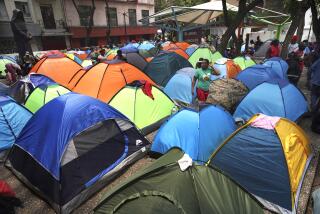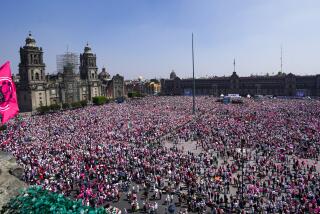MEXICO : Demonstrators Try to Teach Lesson in Economic Survival
MEXICO CITY — For the hundreds of elementary school teachers who have abandoned their classrooms in impoverished rural Mexico in order to paralyze part of the nation’s capital, the lesson has been one of dignity, economics and survival.
“Every teacher I know has to do something other than teach to make a decent living now,” said a 41-year-old primary school teacher, who gave her name only as Martha, as she joined a human blockade outside the Department of Education building here.
Explaining why she left a poor schoolhouse with too few desks and too few teachers in Mexico’s Guerrero state to sleep, eat and protest on the streets of the capital, Martha added: “That’s why we’re here. To dignify the profession and the lives of teachers.”
The educators’ basic demand is a 100% raise in wages that now average $150 a month.
Over the past two weeks, their sometimes-violent protest has shuttered the Department of Education, rid the city of an unpopular police chief, won wide street support for a cause that affects almost every Mexican family and reminded the nation of the depth of its economic crisis.
With more demonstrations scheduled to fill Mexico City’s streets today, the teachers have also elevated the debate about freedom of expression versus law and order to the level of Mexico’s presidency.
Shocked by images of riot police clubbing elementary school teachers during their first street protest last week, President Ernesto Zedillo summoned Mexico City Police Chief David Garay Maldonado to his office on Tuesday. Zedillo, who served as education secretary until he ran for president two years ago, demanded an explanation. Twenty minutes later, he demanded Garay’s resignation.
“Violence,” the president’s spokesman said, “should not be met with violence.”
That was just the first lesson the protesting teachers taught this city of 20 million, which applauded Garay’s departure with near-unanimity.
In the days after last week’s protest, teachers in Guerrero and Michoacan--two of Mexico’s poorest states--have taken over government buildings, banks and shopping malls. They have staged wildcat strikes at schools there and in the capital. And they pledge to continue their protests until the government gives in on wages.
“Our main reason for holding these strikes is the miserable economic conditions of our teachers,” said Gonzalo Martinez, secretary general of the striking division of the National Teachers Union, which represents 1.4 million education workers.
As a result of the crisis that began with the government’s December 1994 peso devaluation, Martinez said, “we have lost up to 80% of our buying power. Teachers earn a base salary of 47 pesos [about $6] a day, which only buys 50% of the basic basket of goods. We want a just salary because now most teachers have to look for a second job--as a taxi driver or selling clothes or tacos.”
For Martha and the hundreds of other primary school teachers camped outside the Department of Education, it is a problem that also harms the image of one of Mexico’s most respected professions--and, eventually, harms an entire generation of Mexicans.
“The schools themselves have been affected by the crisis,” she said. “We don’t have enough desks, materials and--more serious--we don’t have enough teachers.”
Worse still, she said, if the crisis continues, schools like hers will soon run short of students.
“A lot of kids just finish primary school,” she said. “And now, a lot don’t even plan to go to primary school because they can’t afford the notebooks and pencils.”
Times researcher Shasta Darlington in Mexico City contributed to this report.
More to Read
Sign up for Essential California
The most important California stories and recommendations in your inbox every morning.
You may occasionally receive promotional content from the Los Angeles Times.










